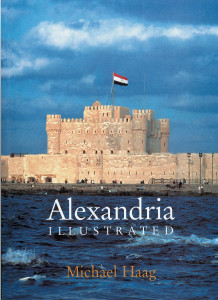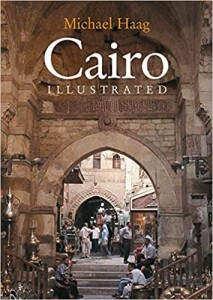 If you read these pages with any regularity, you may have noticed by now that I am hopelessly enamored of books about modern Egypt. Fiction, history, travel, you name it, I’ll gladly give it a try. So I was beside myself when these lovely picture books showed up in a package from International Publishers Marketing.
If you read these pages with any regularity, you may have noticed by now that I am hopelessly enamored of books about modern Egypt. Fiction, history, travel, you name it, I’ll gladly give it a try. So I was beside myself when these lovely picture books showed up in a package from International Publishers Marketing.
If these books are any indication, London-based writer and photographer Michael Haag also is fascinated by modern Egypt. They are a feast for the eyes, with just enough narrative to provide a context for the photographs.
Alexandria Illustrated and Cairo Illustrated both are oversized trade paperbacks. The covers are heavy stock with a matte finish and feature striking examples of the photos that grace the pages. The inside pages are glossy stock, also fairly heavy in weight. The books have stitched binding, which suggests that they may bear repeated viewings without suffering spine damage. Each book begins with a chronology of events and a number of simple, nicely drawn maps at different scales. In each book, one map includes numbered references to key places of interest, which subsequently form the outline for the rest of the book. Alexandria Illustrated is eighty pages long, while Cairo Illustrated runs just under one hundred pages.
 Haag has arranged the photos to follow the maps, so that a visitor to each city could easily use the books to inform walking tours of different districts. Haag’s accompanying narrative makes this intention explicit, referring to places within walking distance of one another. In addition to the narrative that links the photos as if they were part of a walking tour, the photos themselves bear rather detailed captions. In both of these books, the author took most of the photographs. Other photo credits are listed on the contents page of each book.
Haag has arranged the photos to follow the maps, so that a visitor to each city could easily use the books to inform walking tours of different districts. Haag’s accompanying narrative makes this intention explicit, referring to places within walking distance of one another. In addition to the narrative that links the photos as if they were part of a walking tour, the photos themselves bear rather detailed captions. In both of these books, the author took most of the photographs. Other photo credits are listed on the contents page of each book.
In each book, the predominant subject of the photos is the city itself, as shown in sweeping aerial views, building exteriors and interiors, street scenes and shots of bodies of water (the Mediterranean for Alexandria, the Nile for Cairo). There are a few shots of artifacts, but these are in the minority.
Haag does a splendid job of showing the cities in their antiquity as well as their modernity. In Alexandria Illustrated, Haag explains that the Canopic Way was once the main east-west road through the city, then shows photographs of buildings dating from the fourth century and of Pastroudi’s, a restaurant opened in 1923 and frequented by such literary notables as Lawrence Durrell (who wrote the Alexandria Quartet). In Cairo Illustrated, I appreciated seeing a photo of the Nilometer, which was used for centuries to anticipate the year’s harvests by measuring the height of the river (the present structure dates from 861), as well as a shot of the entryway to the famous Groppi’s tearoom – a site of memorable scenes in many novels I’ve read.
 Although written by the same author and on the same press, Vintage Alexandria:
Although written by the same author and on the same press, Vintage Alexandria:
Photographs of the City, 1860-1960 takes a very different tack from the other two books in this review. It’s cloth bound, for starters, and longer than Alexandria Illustrated by some fifty pages. The photographs are taken from archival sources including a number of private collections and even a few post cards; photo credits are in the back of the book. Most of the photos are reproduced in sepia tones, adding to the sense of their antiquity. Apart from a brief introduction and the captions that accompany each photo, there is very little text in this book.
(American University in Cairo Press, 2005)
(American University in Cairo Press, 2006)
(American University in Cairo Press, 2008)
